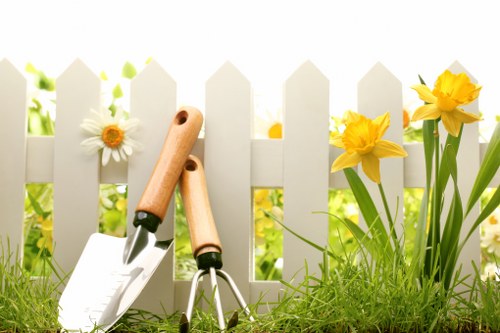Hedge Trimming in Enfield

Hedge trimming is an essential aspect of maintaining a beautiful and healthy garden in Enfield. Whether you have a small backyard or a sprawling estate, regular upkeep of your hedges can significantly enhance the overall appearance of your property. In this article, we will explore the various aspects of hedge trimming, its benefits, and how to choose the right service provider in Enfield.
Maintaining your hedges not only contributes to the aesthetic appeal of your garden but also promotes the health and longevity of the plants. Proper trimming ensures that your hedges grow uniformly and remain free from pests and diseases. Moreover, well-maintained hedges can serve as effective windbreaks, providing privacy and reducing noise from the surrounding environment.
Enfield boasts a vibrant community of gardening enthusiasts who understand the importance of regular hedge maintenance. With the right tools and expertise, hedge trimming can be a straightforward task that yields impressive results. However, for those who prefer to leave it to the professionals, finding a reliable hedge trimming service in Enfield is crucial.

Importance of Hedge Trimming
Regular hedge trimming offers numerous benefits that extend beyond mere appearance. Let's delve into some of the key reasons why hedge trimming is important:
- Enhances Curb Appeal: Well-trimmed hedges create a neat and organized look, significantly boosting the curb appeal of your home or garden.
- Promotes Healthy Growth: Trimming removes dead or diseased branches, allowing the plant to focus its energy on healthy growth.
- Maintains Safety: Overgrown hedges can obstruct pathways and create hiding spots for pests. Regular trimming ensures clear visibility and reduces potential hazards.
Enhances Curb Appeal
Aesthetically pleasing hedges can transform the look of your property. Regular trimming ensures that your hedges maintain a uniform shape and size, contributing to an overall harmonious garden design.
Promotes Healthy Growth
By removing dead or diseased branches, hedge trimming encourages the growth of new shoots and maintains the plant's overall health. This practice prevents the spread of diseases and enhances the plant's resilience against pests.
Maintains Safety
Overgrown hedges can pose safety risks by blocking walkways or becoming entangled in structures. Trimming helps maintain clear pathways and minimizes the risk of accidents.

Choosing the Right Hedge Trimming Service in Enfield
Selecting a reputable hedge trimming service is essential to ensure that your hedges receive the best care possible. Here are some factors to consider when choosing a service provider in Enfield:
- Experience and Expertise: Look for professionals with a proven track record in hedge trimming. Experienced gardeners understand the specific needs of different hedge types and employ the right techniques.
- Quality of Equipment: A reliable service provider uses high-quality tools and equipment to deliver precise and efficient trimming.
- Customer Reviews and Testimonials: Positive feedback from previous clients indicates the reliability and quality of the service.
Experience and Expertise
Experienced hedge trimmers possess the knowledge and skills required to handle various hedge types. They can identify the best trimming methods to promote healthy growth and maintain the desired shape.
Quality of Equipment
High-quality tools make a significant difference in the outcome of hedge trimming. Professional services invest in the latest equipment to ensure clean cuts and efficient work.
Customer Reviews and Testimonials
Reading reviews and testimonials can provide insights into the service quality. Positive experiences from other customers are a good indicator of a trustworthy service provider.

Types of Hedges and Trimming Techniques
Different types of hedges require specific trimming techniques to maintain their shape and health. Understanding these differences can help in selecting the appropriate trimming method.
- Formal Hedges: These hedges have a structured and symmetrical appearance. Trimming them requires precise cuts to maintain their clean lines.
- Informal Hedges: These are more natural-looking and less structured. They allow for a more relaxed trimming approach, focusing on overall shape rather than strict symmetry.
- Different Trimming Methods: Techniques such as shearing, clipping, and shaping are employed based on the hedge type and desired outcome.
Formal Hedges
Formal hedges, such as boxwood or privet, are commonly used for creating neat boundaries and topiaries. Regular shearing is essential to maintain their precise shape and dense foliage.
Informal Hedges
Informal hedges, like yew or hawthorn, offer a more natural look. Trimming these hedges involves removing overgrown branches and encouraging a fuller, more bushy appearance without strict geometric shapes.
Different Trimming Methods
Depending on the hedge type, different trimming techniques are applied. For example, topiary requires careful shaping with shears, while informal hedges benefit from general clipping to promote healthy growth.

Seasonal Hedge Maintenance
Each season brings unique challenges and requirements for hedge maintenance. Adapting your trimming routine to the seasonal changes ensures that your hedges remain healthy and robust throughout the year.
Spring Trimming
Spring is an ideal time for hedge trimming as it encourages new growth. Removing winter damage and shaping the hedges prepares them for a productive growing season.
Summer Maintenance
During the summer, regular trimming helps manage the rapid growth and prevents hedges from becoming too dense. It's also a good time to address any pest issues.
Autumn and Winter Care
In autumn, focus on clean-up trimming to remove any damaged or dead branches. Minimal trimming in winter helps protect hedges from frost damage and prepares them for the next growing season.
Benefits of Professional Hedge Trimming
Hiring professionals for hedge trimming offers several advantages that contribute to the overall health and appearance of your hedges.
- Time-Saving: Professional trimmers work efficiently, saving you time and effort.
- Expertise and Knowledge: They understand the specific needs of different hedge types and apply the best trimming techniques.
- Proper Tool Usage: Professionals have access to high-quality tools and know how to use them safely and effectively.
Time-Saving
Trimming hedges can be time-consuming, especially for large properties. Professionals can complete the task quickly, allowing you to focus on other responsibilities.
Expertise and Knowledge
Experienced trimmers can identify and address issues that may not be apparent to the untrained eye, ensuring that your hedges remain healthy and well-shaped.
Proper Tool Usage
Using the right tools is crucial for effective hedge trimming. Professionals have the necessary equipment and expertise to deliver precise and clean cuts, which promotes healthy growth.
Tips for Maintaining Hedges Between Trims
Even between professional trimming sessions, you can take steps to keep your hedges in top condition. Here are some maintenance tips:
- Regular Watering: Ensure your hedges receive adequate water, especially during dry spells.
- Mulching: Apply mulch around the base to retain moisture and suppress weeds.
- Pest Control: Monitor for pests and treat infestations promptly to prevent damage.
Regular Watering
Consistent watering helps your hedges stay hydrated and vigorous. Deep watering encourages strong root growth and overall plant health.
Mulching
Mulching not only conserves moisture but also enriches the soil with nutrients. It creates a protective barrier against extreme temperatures and weed growth.
Pest Control
Regularly inspect your hedges for signs of pests or diseases. Early detection and treatment can prevent significant damage and maintain the health of your plants.
Conclusion
Maintaining well-trimmed hedges in Enfield is essential for both aesthetic and practical reasons. Whether you choose to undertake the task yourself or hire professional services, regular hedge trimming ensures that your garden remains beautiful and your plants healthy.
Contact us today to schedule your hedge trimming service and experience the difference a well-maintained garden can make!

